Pathogens such as Fusarium, Pythium, Phytophthora, Thielaviopsis and Rhizoctonia that cause pre- and post-emergent damping-off can cause serious problems in organic (and conventional) production.
The key to controlling and/or suppressing damping-off pathogens with biological controls is keeping the biological populations high and continually present on root surfaces of the host, and by following good cultural practices. [Read more…]
Organic Production: Suppressing Soil-borne Pathogens in 2022
Scouting for Broad Mites in the Greenhouse
Broad mites (Polyphagotarsonemus latus) are an extremely small species of mites that affect many ornamental crops. At this point in the season they may be active in the greenhouse and should be included in all greenhouse IPM scouting programs. Broad mites are only 0.2 mm long, which is about half the size of a two-spotted spider mite. This makes them nearly impossible to spot with the naked eye during regular routine scouting and challenging to locate, even with the use of a hand lens. They have a translucent yellow-green appearance and a short but rapid life cycle ranging from 5 to 13 days.
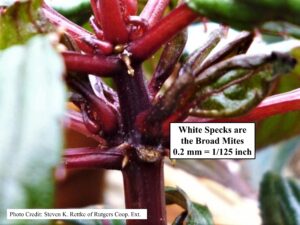
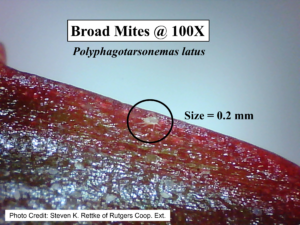
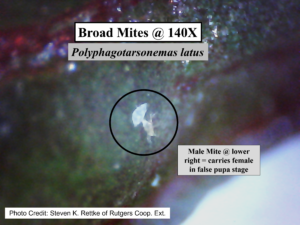
Broad mites feed on new growth and emit saliva that is toxic to the plants. This results in leaf curl, stunting, and deformity that may be mistaken for herbicide damage, physiological disorders, or a fungal pathogen. Broad mites tend to favor New Guinea impatiens, Sunpatiens, and dahlia in the greenhouse this time of year, though they may also cause damage to gerbera, ivy, lantana, standard impatiens, snapdragon, verbena, begonia, and zinnia. They can spread via plant-to-plant contact and may even hitchhike on whiteflies or aphids to reach a new destination.
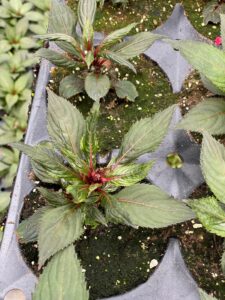
Broad mite damage on Sunpatiens. Notice the stunted growth and leaf curling. Photo: W. Errickson
Control can be achieved using miticides that are labeled specifically for broad mites, as some materials that are effective against two-spotted spider mites and spruce spider mites may not work as well on broad mites. Effective materials include Akari, Avid, Dormant Oil, Judo, Magus, Pylon, SanMite, Sirocco, Summer Oil, and Triact. Always follow the instructions on the label and take note of any sensitivities for use on specific plant species. Rotating chemical classes is also very important when treating broad mites because their rapid life cycle has the potential to lead to the development of resistance in a short period of time. Biological controls involving the release of predatory mites that feed on broad mites have also demonstrated success. Predatory mite species that are effective against broad mites include Amblyseius swirskii, Neoseiulus cucumeris, and N. californicus. Broad mites can be effectively managed in the greenhouse if they are detected early and correctly identified as part of a regular IPM program.
Additional Resources
Broad Mites Fact Sheet, University of Tennessee
https://go.rutgers.edu/zg9kdzod
Broad Mites in Ornamental Crops, Michigan State University
https://go.rutgers.edu/56gic7up
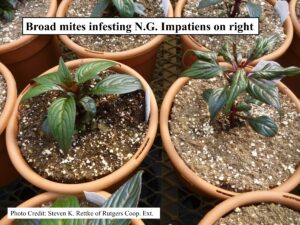 Dealing with Broad Mite, Greenhouse Product News
Dealing with Broad Mite, Greenhouse Product News
https://go.rutgers.edu/6doflkwc
Broad Mite is Becoming an Increasing Problem, Greenhouse Management
Weed Science Webinar Series
Weed Science Webinar Series
USDA – ARS and the Weed Science Society of America (WSSA) are co-hosting 10 webinars on weed science and research. Beginning April 5, presentations will be given by ARS weed science research experts.
The webinars will occur every Tuesday from 2-3p.m. Eastern Time (ET) and include an interactive Q&A session.
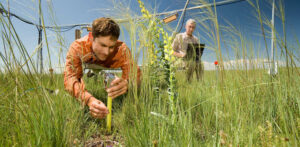
Weed Science Webinar Series Schedule
April 5
ARS Weed Science: Past, Present, and Future: Steve Duke, Principal Scientist at the National Center for Natural Products Research at the University of Mississippi, Steve Young, National Program Leader – Weeds and Invasive Pests, WSSA Representatives and ARS Administrators
Meeting Information:
Zoom Meeting Link
Webinar ID: 831 3320 1055
Passcode: 825921
Please download and import the following iCalendar (.ics) files to your calendar system.
Theme I: Tactics
April 12
Integrated Weed Management in Cropping Systems: Marty Williams, Ecologist at the Global Change and Photosynthesis Research Unit in Urbana, IL
April 19
Non-Crop Systems: Advancements in Weed Biocontrol Tools: Melissa Smith, Research Ecologist at the Invasive Plant Research Laboratory in Fort Lauderdale, FL
April 26
New Technology for Weed Identification and Control: Steven Mirsky, Research Ecologist at the Sustainable Agricultural Systems Laboratory in Beltsville, MD
Theme II: Mechanisms
May 3
Role of Plant Physiology in Weed-Crop Competition: Dave Horvath, Research Plant Physiologist at the Sunflower and Plant Biology Research Unit in Fargo, ND
May 10
Molecular Basis for Controlling Invasive Plants: Matt Tancos, Research Plant Pathologist at the Foreign Disease-Weed Science Research Unit in Fort Detrick, MD
May 17
Addressing Herbicide Resistance with Alternative Chemistries: Scott Baerson, Molecular Biologist at the Natural Products Utilization Research Unit in Oxford, MS
Theme III: Impacts
May 24
Spread and Distribution of Invasive Plants: John Madsen, Research Biologist at the Invasive Species and Pollinator Health Unit in Albany, CA
May 31
Climate Change Effects on Weeds and Management: Dana Blumenthal, Ecologist at the Rangeland Resources & Systems Research Unit in Fort Collins, CO
June 7
Restoration for Managing Invasive Plants: Roger Sheley, Ecologist at the Range and Meadow Forage Management Research Unit in Burns, OR
Organic Production: Suppressing Soil-borne Pathogens
Pathogens such as Fusarium, Pythium, Phytophthora, Thielaviopsis and Rhizoctonia that cause pre- and post-emergent damping-off can cause serious problems in organic (and conventional) transplant production.
The key to controlling and/or suppressing damping-off pathogens with biological controls is keeping the biological populations high and continually present on root surfaces of the host, and by following good cultural practices. [Read more…]
Organic Transplant Production: Suppressing Soil-borne Pathogens – A reminder
Pathogens such as Fusarium, Pythium, Phytophthora, Thielaviopsis and Rhizoctonia that cause pre- and post-emergent damping-off can cause serious problems in organic (and conventional) transplant production. The key to controlling and/or suppressing damping-off pathogens with biological controls is keeping the biological populations high and continually present on root surfaces of the host, and by following good cultural practices. [Read more…]
Organic Transplant Production: Suppressing Soil-borne Pathogens
Pathogens such as Fusarium, Pythium, Phytophthora, Thielaviopsis and Rhizoctonia that cause pre- and post-emergent damping-off can cause serious problems in organic (and conventional) transplant production. The key to controlling and/or suppressing damping-off pathogens with biological controls is keeping the biological populations high and continually present on root surfaces of the host, and by following good cultural practices. [Read more…]
